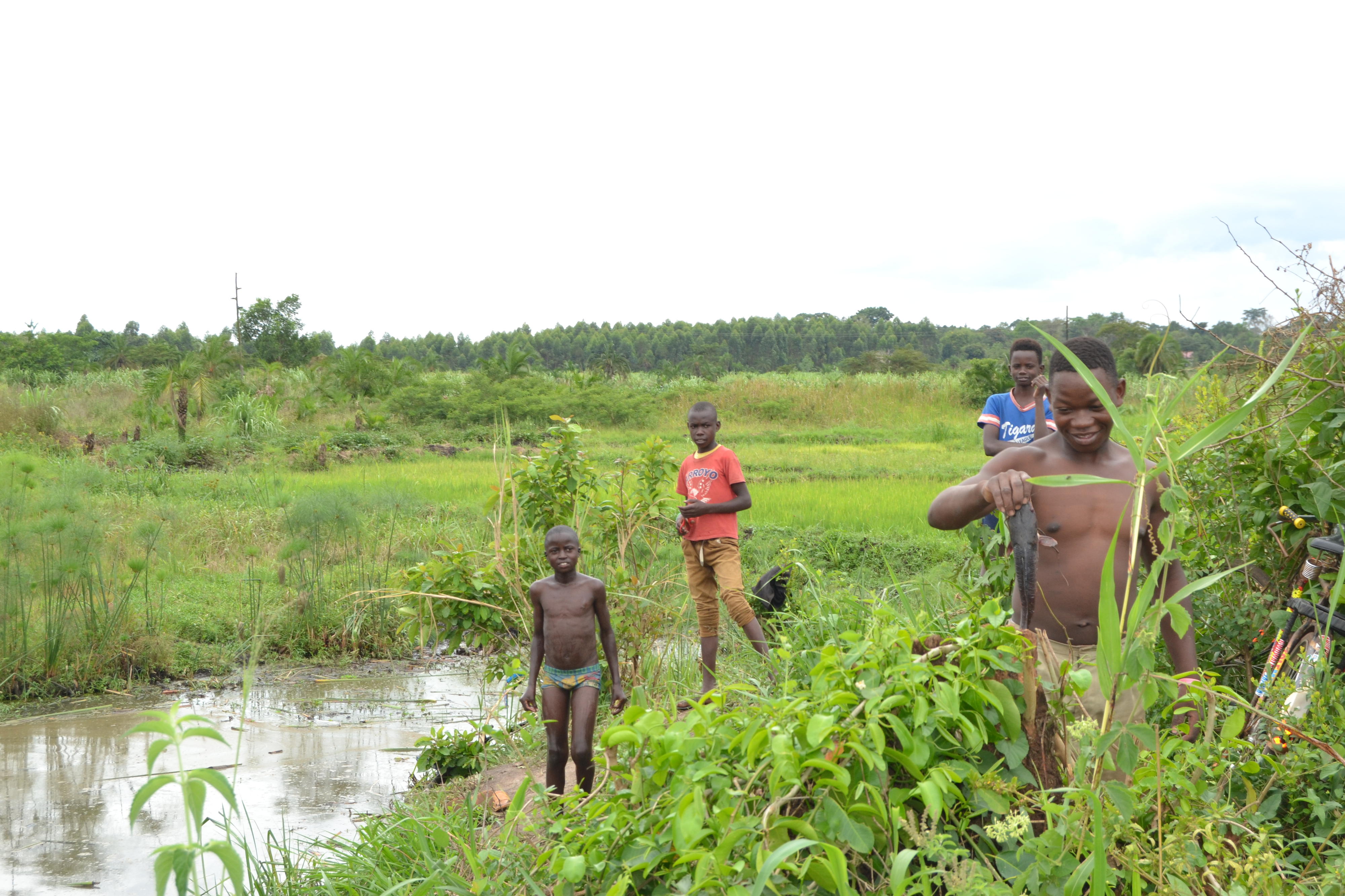Are flash floods disrupting fight against malaria in Nakasongola?

Children swim and fish at the Lugogo swamp and drainage channel in Kakooge Subcounty, Nakasongola District. PHOTO | DAN WANDERA
What you need to know:
- In Uganda, malaria, a preventable illness, is a severe threat, especially to children under five years of age. A number of factors have contributed to holding back the progress in the fight against malaria, from drug resistance to misuse of mosquito nets, and now, as Dan Wandera writes, climate change is becoming serious hindrance.
The World Health Organisation (WHO) Global technical strategy set an ambitious global target on malaria, which calls for a 90 percent reduction in case incidence and mortality rates by 2030.
However, these targets could be derailed, according to the 2023 World Malaria Report, which indicates that, “changes in temperature, humidity and rainfall can influence the behaviour and survival of the malaria-carrying Anopheles mosquito. Extreme weather events, such as heat waves and flooding, can also directly impact transmission and disease burden.”
For Sunday Ssekabembe, a resident of Kabasombwe village, Lwampanga Sub-county, in Nakasongola District, 2022 will remain a year filled with sad memories.
“I have seven children, and in that year, four of them and I were in and out of Lwampanga Health Centre III, severely ill with malaria. I spent a lot of money on their treatment. We could not concentrate on our farm, yet it is our main source of income. At one time, our relatives advised me to visit traditional healers because the malaria was recurrent,” he says.
Ssekabembe and his neighbours now attribute the disease to the stagnant water around them.
“The waters only recede after three or four months, living behind overgrown vegetation. We now use mosquito nets but we supplement them by burning natural mosquito repellents around our home,” he says.
Three sub-counties and two town councils that account for more than 55 percent of the total population of Nakasongola District are trapped in a malaria disease cycle that stakeholders are now partly blaming on swampy vegetation and persistent flash floods in the affected areas. The disease burden is high in Lwampanga, Nabiswera, Kalungi, and Kakooge sub-counties.
While the greater Kakooge area is within the Rivers Lugogo and Kafu drainage channels, the sub-counties of Kalungi, Lwampanga and Nabiswera fall within the Lake Kyoga basin and River Ssezibwa. The flash floods from these rivers and Lake Kyoga occupy hundreds of hectares of the settlement areas of Nakasongola District, and take months to recede, creating breeding grounds for mosquitoes.
Management strategies
Statistics for the 2022/2023 Financial Year put the malaria disease burden and mortality rate at 40.3 percent in Nakasongola District, accounting for 99,810 cases in the same period. Of these, 44,687 cases were male and 55,123 cases were female.

A section of the Out patient department at Nakasongola Health Centre IV. PHOTO | DAN WANDERA.
This is a slight decrease from the 2021/2022 Financial Year, where the disease burden and mortality rate was at 41.5 percent with a total of 103,401 cases.
Sam Kigula, the district chairperson, says the floods are a natural catastrophe that may not be immediately controlled.
“We cannot cut down the swampy vegetation, but residents have to be encouraged to adhere to malaria preventive measures, such as the use of mosquito nets and mosquito repellents. The district has also adapted the test, treat and track strategy and we call on the National Medical Stores to continue supplying the district with the necessary drugs,” he says.
Dr Agaba Byamukama, the District Health Officer, says a number of awareness campaigns have been launched in the district.
“Working with partners and the Ministry of Health, we have held radio talk shows, facilitated village health teams, and supported the distribution of mosquito nets. Since 2022, more than 350,000 treated mosquito nets have been distributed in two major cycles. Mothers who attend antenatal care and deliver at health facilities are also handed a mosquito net. The campaign to have all health units equipped with drugs and personnel is ongoing,” he says.
Nakasongola District has three health centre IV units, eight health centre III units and 19 health center II units, with 150 registered drug shops spread through the different localities. Jovanice Nsinza, the district malaria focal person says the men are defiant to the different malaria prevention measures.
“Sixty two percent of the population in Lwampanga, Kakooge, and Nabiswera sub-counties and Nakasongola town council are men, while women make up 38 percent. The male population includes soldiers, factory workers, charcoal burners and the fishermen. Many of them do not want to use bed nets, and neither do they want to cut down the bushy grass around their homes. We also register cases where distributed mosquito nets are used as fishing nets,” she says.
Sam Kigula, the district chairperson, blames the rampant drug stock outs. “The reality is that some health units go without malaria drugs for more than two months after the initial stock runs dry. The Ministry of Health and the National Medical Stores should try to address this problem,” he says.
The recurrence of the disease in the same people also depletes the drug stocks in a very short time. Nsinza attributes the recurrence to exposure to mosquitoes after treatment.
However, the WHO has reported that in recent years, in countries like Uganda, Eritrea, and Rwanda, there have been reports of parasite resistance to artemisinin, which is the core compound of the available medicines to treat malaria.
Uganda’s malaria burden
Ministry of Health statistics show that malaria kills about 14 people every day in the country. According to WHO, Uganda carries five percent of the malaria burden in Africa and is one of the countries with the highest malaria incidence rate, with 478 cases per 1,000 population annually.
Malaria is the leading cause of sickness and death in the country and is responsible for up to 40 percent of all outpatient visits, 25 percent of hospital admissions, and 14 percent of all hospital deaths. The WHO estimates Uganda’s malaria death rate to be between 70,000 and 100,000 deaths per year.
Uganda is experiencing a new malaria burden since 2022 with upsurges being recorded in Karamoja, Acholi and Bukedea sub-regions. In January, Dr Michael Baganizai, the head of the immunization programme at the Ministry of Health officials told this newspaper that Uganda will begin the rollout of malaria vaccines in October this year. If rolled out, the country will join Kenya, Ghana and Malawi which have already began the vaccination in four schedules.
According to Target Malaria Uganda, which is hosted at the Uganda Virus Research Institute (UVRI), the annual average economic loss in Uganda due to malaria is more than $500m (Shs1.8b).
Worldwide burden
According to the 2023 World malaria report, there were 249 million cases of malaria in 2022 compared to 244 million cases in 2021. The estimated number of malaria deaths stood at 608,000 in 2022 compared to 610,000 in 2021.
The WHO African Region continues to carry a disproportionately high share of the global malaria burden. In 2022, the region was home to about 94 percent of all malaria cases and 95 percent of deaths. Four African countries accounted for just over half of all malaria deaths worldwide: Nigeria (26.8 percent), the Democratic Republic of the Congo (12.3 percent), Uganda (5.1 percent) and Mozambique (4.2 percent).





